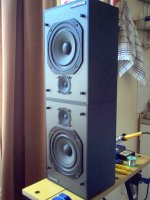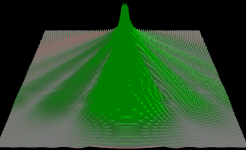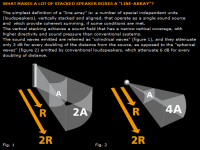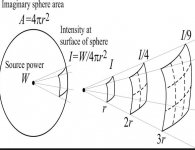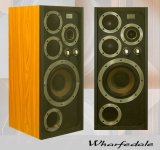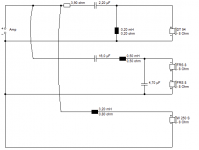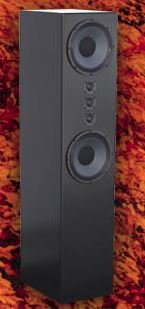I have a set of Bic America FH-65B bookshelf speakers.
[SPEC LINK]
I have been listening to them for a long time, and I really love them!
Can some one explain what would happen if I stack 8 speakers, floor to ceiling, using series/parallel wiring, per channel?
I want to have 8 speakers for the left channel, and 8 speakers for the right channel.
1. Is this a good idea?
2. How do I do it properly?
3. What type amp power would this require?
An externally hosted image should be here but it was not working when we last tested it.
[SPEC LINK]
I have been listening to them for a long time, and I really love them!
Can some one explain what would happen if I stack 8 speakers, floor to ceiling, using series/parallel wiring, per channel?
I want to have 8 speakers for the left channel, and 8 speakers for the right channel.
1. Is this a good idea?
2. How do I do it properly?
3. What type amp power would this require?
Last edited:
1) No.I have a set of Bic America FH-65B bookshelf speakers.
An externally hosted image should be here but it was not working when we last tested it.
[SPEC LINK]
I have been listening to them for a long time, and I really love them!
Can some one explain what would happen if I stack 8 speakers, floor to ceiling, using series/parallel wiring, per channel?
I want to have 8 speakers for the left channel, and 8 speakers for the right channel.
1. Is this a good idea?
2. How do I do it properly?
3. What type amp power would this require?
2) Use tweeters that are small enough to be only a wavelength (or less) distance apart at their crossover point.
3) An amplifier of sufficient power to drive the speakers to the desired SPL (sound pressure level). Using more speakers increases sensitivity, so less power is needed for a given SPL. That said, using more speakers not designed to array vertically will cause severe peaks and dips (comb filtering) in the upper response.
Hi,
1. Not really.
Though you'd stack them on their sides,
which won't give floor to ceiling height.
2. Something like :
Audio Artistry CBT36K Line Array Speaker Pair Kit
Not cheap, but neither are 16 bookshelves.
3. A lot of power if being used as a a PA system.
At home your normal amplifier would fine, even
if you wired the 8 spekers for double impedance.
rgds, sreten.
1. Not really.
Though you'd stack them on their sides,
which won't give floor to ceiling height.
2. Something like :
Audio Artistry CBT36K Line Array Speaker Pair Kit
Not cheap, but neither are 16 bookshelves.
3. A lot of power if being used as a a PA system.
At home your normal amplifier would fine, even
if you wired the 8 spekers for double impedance.
rgds, sreten.
I can never hear combing, myself. Or at least it never bugs me. I must be deaf. 😱
Since these speakers are cheap as chips at $100 a pair, I see no reason why you can't buy a second pair and wire them in series for 16 ohms. But 4 or 8 might be getting silly.
Makes a cheapie MTTM. You gain loudness and authority on axis. Multiple driver's power falls off more slowly with distance, which is why they are used in PA systems.
You can try mono right now.
Since these speakers are cheap as chips at $100 a pair, I see no reason why you can't buy a second pair and wire them in series for 16 ohms. But 4 or 8 might be getting silly.
Makes a cheapie MTTM. You gain loudness and authority on axis. Multiple driver's power falls off more slowly with distance, which is why they are used in PA systems.
You can try mono right now.
Attachments
Multiple drivers SPL (sound pressure level) falls with the usual inverse distance rule, 6 dB per doubling of distance in free space if the acoustic centers of the drivers are within 1/4 wavelength of each other in their pass band.I
Makes a cheapie MTTM. You gain loudness and authority on axis. Multiple driver's power falls off more slowly with distance, which is why they are used in PA systems.
"Line array" SPL also falls at 6 dB per doubling of distance, but the interference pattern in the near field causes the SPL to be relatively lower there, giving the appearance of falling at 3 dB per doubling of distance due to the comb filtering (that you can't hear ;^) ).
To actually make a speaker fall off at 3 dB per doubling of distance requires a parabolic or hyperbolic reflector to concentrate the beam into a coherent wave front.
If you are interested, this thread gives some details into those developments:
HyperboLine ™ Projector
Hi,
Nonsense. All long and thin drivers exhibit the 3dB dispersion at
frequencies above the lines wavelength, and similarly so do line
arrays that are also in the phase coherent region.
rgds, sreten.
And of course long throw horns can also do it easily.
Nonsense. All long and thin drivers exhibit the 3dB dispersion at
frequencies above the lines wavelength, and similarly so do line
arrays that are also in the phase coherent region.
rgds, sreten.
And of course long throw horns can also do it easily.
Last edited:
I went into this looking for a sign of widening directivity at some point but it appears to be persistent with distance (plane source a few wavelengths across). Directivity appears to be related to the interference pattern with some of the power being lost in the 'crossfire'."Line array" SPL also falls at 6 dB per doubling of distance, but the interference pattern in the near field causes the SPL to be relatively lower there, giving the appearance of falling at 3 dB per doubling of distance due to the comb filtering (that you can't hear ;^) ).
Attachments
Last edited:
I always like the mathematics in these sort of situations.
Something about line arrays which I quote in the pictures:
INTRODUZIONE AI SISTEMI "LINE-ARRAY" - Palcoplus - professional array system
Whatever you think of combing, on the horizontal axis there is none. When you double up drivers in an MTTM you are only using half the amplifier power for the same sound level. This must help distortion for one thing, since each driver is only outputting a quarter of the power.
MT has a problem in delivering sound across a room. You've experienced this. Get close to a spherical falloff MT type two way up on the nightclub ceiling and it blasts your ears most unpleasantly.
MTM has a problem too. The tweeter falls off at inverse square, but the twin woofers or mids at inverse distance. I like the MTTM idea, but a certain subtlety in using wider dispersion BW3 filters which is for the real enthusiasts.
How about MTTTM? This is interesting. The Tekton Pendragon uses it. Philips came up with the idea that three stacked drivers should be connected in a 1:2:1 binomial voltage level to lessen vertical combing. Or 1:3:3:1 with 4 drivers. I don't know what Tekton actually do here.
Anyway, lots to think about. It's fun. 🙂
Something about line arrays which I quote in the pictures:
INTRODUZIONE AI SISTEMI "LINE-ARRAY" - Palcoplus - professional array system
Whatever you think of combing, on the horizontal axis there is none. When you double up drivers in an MTTM you are only using half the amplifier power for the same sound level. This must help distortion for one thing, since each driver is only outputting a quarter of the power.
MT has a problem in delivering sound across a room. You've experienced this. Get close to a spherical falloff MT type two way up on the nightclub ceiling and it blasts your ears most unpleasantly.
MTM has a problem too. The tweeter falls off at inverse square, but the twin woofers or mids at inverse distance. I like the MTTM idea, but a certain subtlety in using wider dispersion BW3 filters which is for the real enthusiasts.
How about MTTTM? This is interesting. The Tekton Pendragon uses it. Philips came up with the idea that three stacked drivers should be connected in a 1:2:1 binomial voltage level to lessen vertical combing. Or 1:3:3:1 with 4 drivers. I don't know what Tekton actually do here.
Anyway, lots to think about. It's fun. 🙂
Attachments
Art
A long enough (but finite) line array does fall at 3 dB PDD, but only up to a point and then it falls as 6 dB PDD. People want to ignore the part where the line source ceases to be a line source and becomes a point source. The problem is that this happens at different distance for different frequencies making a "clear" statement impossible.
A long enough (but finite) line array does fall at 3 dB PDD, but only up to a point and then it falls as 6 dB PDD. People want to ignore the part where the line source ceases to be a line source and becomes a point source. The problem is that this happens at different distance for different frequencies making a "clear" statement impossible.
Hi,
It clearly does not suddenly transition from a line source to point source.
Correctly stated its only 3dB down to a point, and then changes to 6dB
over an octave or so. Real distance makes no difference farfield.
rgds, sreten.
It clearly does not suddenly transition from a line source to point source.
Correctly stated its only 3dB down to a point, and then changes to 6dB
over an octave or so. Real distance makes no difference farfield.
rgds, sreten.
The point is that the transition is anything but obvious since its different at every frequency and there are even peaks and dips in the response as one moves away, so there aren't any obvious transitions. To be in the far field of a finite length array one must be many times more distant than the length of the array, and the falloff will always be -6 dB if you are in the far field.
Keeping in the near field so as to avoid any kind of transition hasn't sat well with thoughts I once had of doing this. I've wanted to see a spherical cap implementation of Keele's CBT. I can't find a way to do a quasi spherical floor to ceiling array, but maybe a cylindrical floor to ceiling corner array could do something useful at some frequencies.
Actually if you apply shading to a straight array you can have very uniform response transition as you move away from the array. I have curves that show this.
Rick,Actually if you apply shading to a straight array you can have very uniform response transition as you move away from the array. I have curves that show this.
And I have the results pictured below of what happens to the center tweeters when shading is applied at higher power levels 😉.
The two "mushroom meltdowns" are from a pair of Renkus Heinz ICX7 mini line arrays, the outer pair of (7) tweeters receive -10 dB (1/10th) the power of the center tweeter which is (was) effectively doing most of the
"tweeting".
Before burning out, the center tweeter's voice coils got hot enough to deform the plastic pole piece extending through the woofer voice coil former, which then started rubbing on the pole piece, alerting me to the problem.
Art
Attachments
Rick,
And I have the results pictured below of what happens to the center tweeters when shading is applied at higher power levels 😉.
The two "mushroom meltdowns" are from a pair of Renkus Heinz ICX7 mini line arrays, the outer pair of (7) tweeters receive -10 dB (1/10th) the power of the center tweeter which is (was) effectively doing most of the
"tweeting".
Before burning out, the center tweeter's voice coils got hot enough to deform the plastic pole piece extending through the woofer voice coil former, which then started rubbing on the pole piece, alerting me to the problem.
Art
I've had zero failures with drivers. 😀
- Status
- Not open for further replies.
- Home
- Loudspeakers
- Multi-Way
- Line Array with Bookshelf Speakers Possible?
